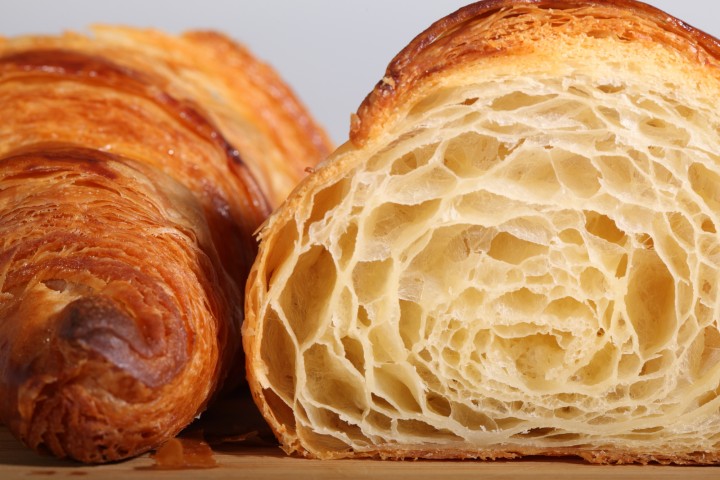
It’s all about the layers…
Klik hier voor Nederlandse versie
With this recipe we want to give you the exact directions on how we go about making classic French croissants. The recipe is an adaptation from the recipe for Classic Croissants by Jeffrey Hamelman. We started out largely following the instructions for his recipe, changed everything to our beloved metric system and found out some worthwhile croissant knowledge of our own along the way. Hopefully enough to justify sharing it all with you and inspiring you to give croissant baking a shot yourself.
Before you start we can recommend watching our croissant making video to get a general feel for the recipe. You can also check out our croissant making log where we keep track of our own croissant baking adventures. For answers to your croissant questions you can check out the Frequently Asked Croissant Questions section.
This recipe will yield about 15 good croissants plus some leftover bits which you can use to make a few, slightly odd shaped ones, or other inventive croissant-like creations.
If at first you don’t succeed, maybe you can take comfort from the fact that our first efforts were not very ‘croissant worthy’. But as you can see we persevered and got better…But we have to admit it is and always will be a tricky process. You have to work precise and be focused to get good results. So away with screaming children, hyperactive animals and all other things distracting! Put on some appropriate croissant making music and lets get to it…
Please read the following tips;
According to Raymond Calvel croissants laminated with margarine are formed into the crescent shape, while croissants laminated with butter are left in the straight form. We say, use whichever shape you like best, but do use butter!
The croissant recipe

Ingredients for the croissant dough
500 g French Type 55 flour or unbleached all-purpose flour / plain flour (extra for dusting)
140 g water
140 g whole milk (you can take it straight from the fridge)
55 g sugar
40 g soft unsalted butter
11 g instant yeast
12 g salt
Other ingredients
makes 15
280 g cold unsalted butter for laminating
1 egg + 1 tsp water for the egg wash
Day 1
Making the croissant dough
We usually do this part in the evening. Combine the dough ingredients and knead for 3 minutes, at low to medium speed, until the dough comes together and you’ve reached the stage of low to moderate gluten development. You do not want too much gluten development because you will struggle with the dough fighting back during laminating. Shape the dough like a disc, not a ball, before you refrigerate it, so it will be easier to roll it into a square shape the following day. Place the disc on a plate, cover with clingfilm and leave in the fridge overnight.
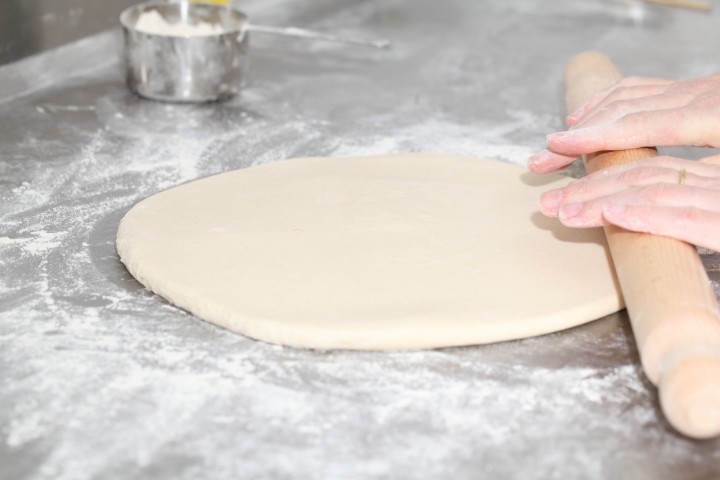
Day 2
Laminating the dough
Cut the cold butter (directly from the fridge) lengthwise into 1,25 cm thick slabs. Arrange the pieces of butter on waxed paper to form a square of about 15 cm x 15 cm. Cover the butter with another layer of waxed paper and with a rolling pin pound butter until it’s about 19 cm x 19 cm. Trim / straighten the edges of the butter and put the trimmings on top of the square. Now pound lightly until you have a final square of 17 cm x 17 cm. Wrap in paper and refrigerate the butter slab until needed.
Take the dough out of the fridge. With a rolling pin roll out the dough disc into a 26 cm x 26 cm square. Try to get the square as perfect as possible and with an even thickness. Get the slab of butter from the fridge. Place the dough square so one of the sides of the square is facing you and place the butter slab on it with a 45 degree angle to the dough so a point of the butter square is facing you. Fold a flap of dough over the butter, so the point of the dough reaches the center of the butter. Do the same with the three other flaps. The edges of the dough flaps should slightly overlap to fully enclose the butter. With the palm of your hand lightly press the edges to seal the seams.
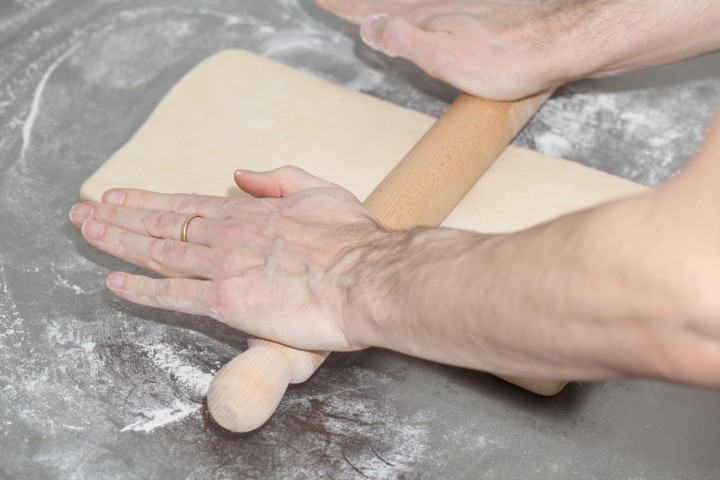
Now the dough with the sealed in butter needs to be rolled out. With a lightly floured rolling pin start rolling out, on a lightly flour dusted surface, the dough to a rectangle of 20 x 60 cm. Start rolling from the center of the dough towards the edges, and not from one side of the dough all the way to the other side. This technique helps you to keep the dough at an even thickness. You can also rotate your dough 180 degrees to keep it more even, because you tend to use more pressure when rolling away from you than towards yourself. You can use these techniques during all the rolling steps of this recipe. Aim at lengthening the dough instead of making it wider and try to keep all edges as straight as possible.
Fold the dough letter style, cover with clingfilm and refrigerate for 30 minutes (fold one third of the dough on top of itself and then fold the other side over it). Repeat the rolling and folding two more times (ending up with 27 layers of butter in total), each time rolling until the dough is about 20 cm x 60 cm. After each fold you should turn the dough 90 degrees before rolling again. The open ‘end’ of the dough should be towards you every time when rolling out the dough (you can see this in our croissant making video at around 3:40 minutes). After the second turn, again give it a 30 minute rest in the fridge. After the third turn you leave the dough in the fridge overnight until day 3, the actual croissant making day!
- Roll out to 20 cm x 60 cm
- Fold
- Refrigerate 30 minutes
- Rotate 90 degrees
- Roll out to 20 cm x 60 cm
- Fold
- Refrigerate 30 minutes
- Rotate 90 degrees
- Roll out to 20 cm x 60 cm
- Fold
- Refrigerate until day 3
- Rotate 90 degrees
- Roll out to 20 cm x 110 cm
Also see complete time table at bottom of page
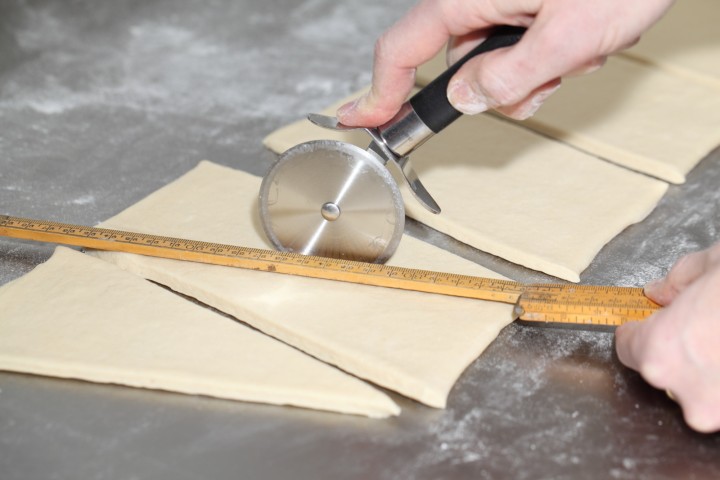
Day 3
Dividing the dough
Take the dough from the fridge. Lightly flour your work surface. Now very gently roll the dough into a long and narrow strip of 20 cm x 110 cm. If the dough starts to resist too much or shrink back during this process you can fold it in thirds and give it a rest in the fridge for 10 to 20 minutes before continuing. Do not fight the dough, when the dough refuses to get any longer, rest it in the fridge! It is such a shame to ruin two days of work.
When your dough has reached its intended shape, carefully lift it a few centimeters to allow it to naturally shrink back from both sides. This way it will not shrink when you cut it. Your strip of dough should be long enough to allow you to trim the ends to make them straight and still be left with a length of about 100 cm.
Shaping the croissants
For the next stage you will need a tape measure and a pizza wheel. Lay a tape measure along the top of the dough. With the wheel you mark the top of the dough at 12,5 cm intervals along the length (7 marks total). Now lay the tape measure along the bottom of the dough and make a mark at 6,25 cm. Then continue to make marks at 12,5 cm intervals from this point (8 marks total). So the bottom and the top marks do not align with each other and form the basis for your triangles.
Now make diagonal cuts starting from the top corner cutting down to the first bottom mark. Make diagonal cuts along the entire length of the dough. Then change the angle and make cuts from the other top corner to the bottom mark to create triangles. Again repeat this along the length of the dough. This way you will end up with 15 triangles and a few end pieces of dough.
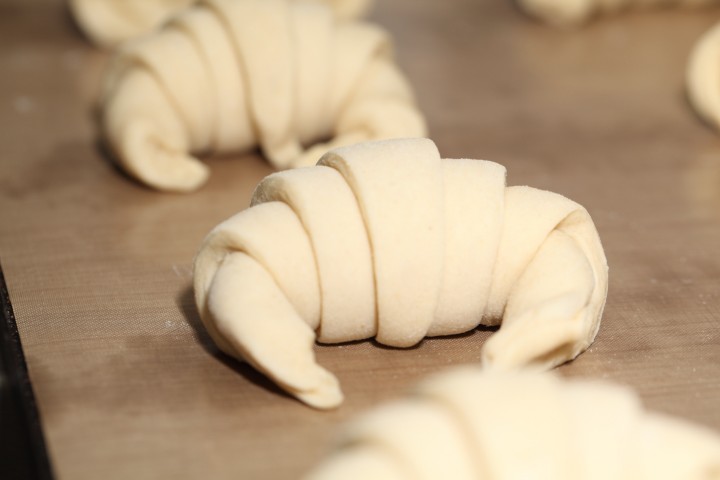
Using your pizza wheel, make 1.5 cm long notches in the center of the short side of each dough triangle.
Now very gently elongate each triangle to about 25 cm. This is often done by hand, but we have found that elongating with a rolling pin, very carefully, almost without putting pressure on the dough triangle, works better for us. You can try both methods and see what you think gives the best result.
After you cut a notch in the middle of the short end of the triangle, try and roll the two wings by moving your hands outwards from the center, creating the desired shape with a thinner, longer point. Also try and roll the dough very tightly at the beginning and put enough pressure on the dough to make the layers stick together (but not so much as to damage the layers of course).
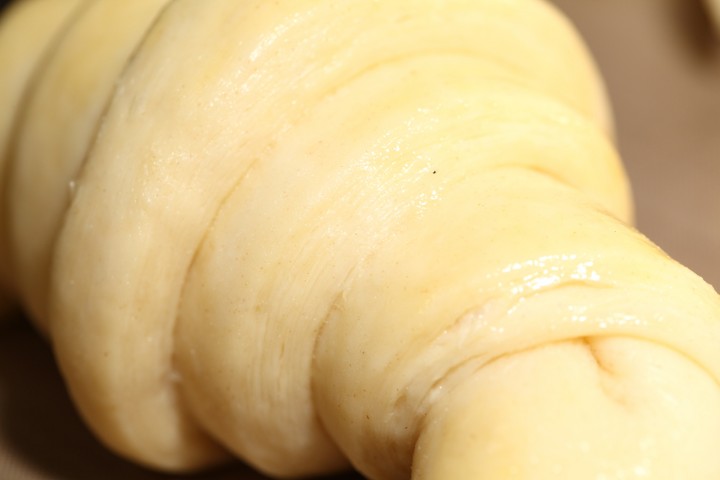
Proofing and baking
Arrange the shaped croissants on baking sheets, making sure to keep enough space between them so they will not touch when proofing and baking. Combine the egg with a teaspoon of water and whisk until smooth. Give the croissants their first thin coating of egg wash. You do not need to cover the croissants with anything, the egg wash will prevent the dough from drying out.
Proof the croissants draft-free at an ideal temperature of 24ºC to 26.5ºC / 76ºF to 79ºF (above that temperature there is a big chance butter will leak out!). We use our small Rofco B20 stone oven as a croissant proofing cabinet by preheating it for a minute to 25ºC / 77ºF. It retains this temperature for a long time because of the oven stones and isolation. The proofing should take about 2 hours. You should be able to tell if they are ready by carefully shaking the baking sheet and see if the croissants slightly wiggle. You should also be able to see the layers of dough when looking at your croissants from the side.
Preheat the oven at 200ºC / 390ºF convection or 220ºC / 430ºF conventional oven.
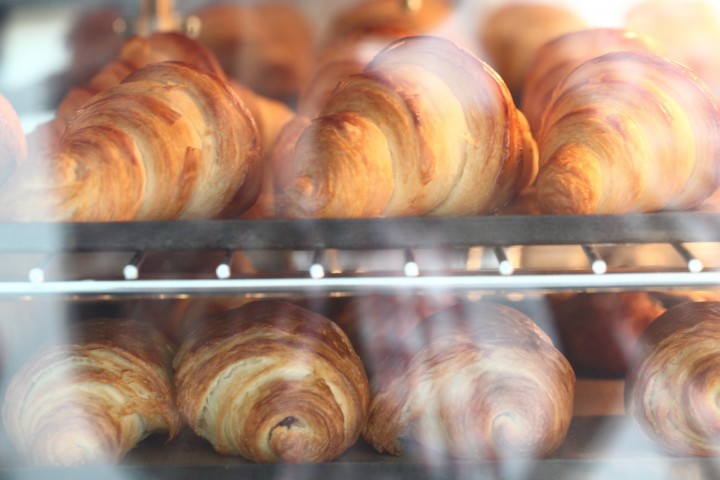
Right before baking, give the croissants their second thin coat of egg wash. We bake the croissants in our big convection oven for 6 minutes at 195ºC / 385ºF, then lowering the temperature to 165ºC / 330ºF, and bake them for another 9 minutes. Hamelman suggest baking the croissants for 18 to 20 minutes at 200ºC / 390ºF , turning your oven down a notch if you think the browning goes too quickly. But you really have to learn from experience and by baking several batches what the ideal time and temperature is for your own oven. Take out of the oven, leave for a few minutes on the baking sheet, then transfer to a cooling rack.
Latest way of baking; We heat up our double fan big convection oven at 200ºC, when heated up put the croissants in the oven and directly lower it to 175ºC. We bake them for 10 minutes at 175ºC, they will have a nice brown color by now, then lower the temperature to 150ºC, and bake them for another 6 minutes.
Best eaten while warm and fresh of course. Croissant we don’t eat or share within a day we freeze. We put them in the preheated oven (180ºC / 355ºF) for 8 minutes straight from the freezer. Nothing wrong with that, croissants eaten nice and warm, almost as good as the fresh ones…almost!
Croissant Time Table
Times are an indication and also depend on your experience with the recipe
Try to work swift but precise and take extra fridge time if needed!
Day 1 – Make initial dough
- 21.00 h – Knead for 3 minutes and store in fridge for 12 hours
Day 2 – Laminate the dough
- 09.00 h – Make butter slab and refrigerate till needed
- 09.05 h – Roll dough disc into square
- 09.10 h – Seal butter in dough
- 09.15 h – Roll out to 20 cm x 60 cm and fold
- Refrigerate 30 minutes
- 09.50 h – Rotate 90 degrees
- Roll out to 20 cm x 60 cm and fold
- Refrigerate 30 minutes
- 10.25 h – Rotate 90 degrees
- Roll out to 20 cm x 60 cm and fold
- 11.00 h – Refrigerate until day 3
Day 3 – Dividing, Shaping, proofing and baking
- 09.00 h – Roll out to 20 cm x 110 cm – part 1
- 09.05 h – Often needed! Take 20 min. fridge time if length not in one go
- 09.25 h – Roll out to 20 cm x 110 cm – part 2
- 09.30 h – Divide and shape the croissants
- 09.40 h – First coat of egg wash
- 09.45 h – Proof to perfection (indication 2 hours)
- 11.45 h – Second coat of egg wash
- 11.50 h – Bake for 15-18 minutes
- 12.10 h – Ready!







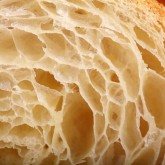
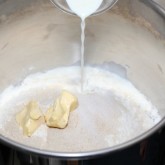
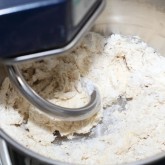
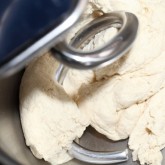
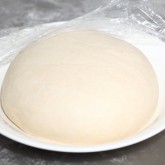
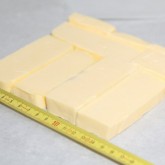
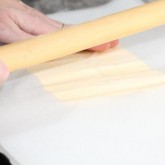
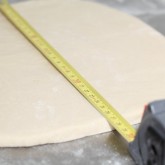
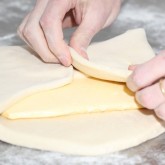
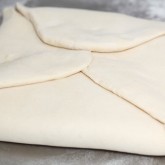

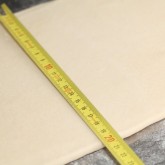
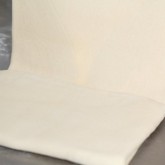
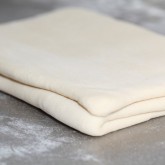
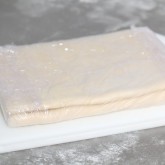

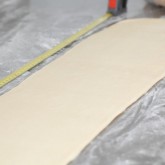
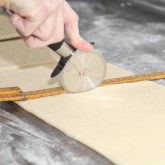
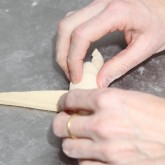






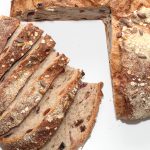



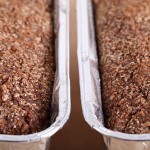

Benars says
Thanks for the supper receip
Weekend Bakers says
Glad you like it too Benars!
Juliet says
I have not baked before, but I need to learn. Please help me.
Weekend Bakers says
We have all the instructions, a blog, a video and a Q&A about croissants for you. You could also consider taking a workshop with a baker.
Alex says
Hi!
I made the dough yesterday and left it in the fridge overnight and now I see that it looks quite dry and it has grown, but not very much. Should I do a new dough or use it this one?
Weekend Bakers says
Did you cover the dough well in the fridge or did it really dry out?
Alex says
It’s a little bit dry, I covered it food drap.
Weekend Bakers says
If the dough is just a little bit dry and you are sure the yeast is working properly, you can move to the next stage. Be sure to use very little flour when rolling to avoid making your dough too dry. If needed leave the dough out of the fridge for a little while to get less cold (depending on the temperature where you live and in your room of course).
You can find more answers and tips to help you during the process here: www.weekendbakery.com/posts…questions/
Dimitrios says
Also, after proofing my croissants and applying the eggwash
they decrease drastically in size.
Any thoughts?
Weekend Bakers says
Hello again,
Dough should not decrease when you apply the eggwash. Of course you have to apply it very carefully without using pressure on the dough, but if your dough decreases / collapses with just a slight touch, the dough could be over-proofed, so you need to keep an eye on it (because of the warm climate your dough could need less time to develop).
Dimitrios says
How do I keep the butter from coming out from the dough when rolling ? It comes out from the dough then sticks on my workarea. I feel like I’m being too slow and the butter gets warm. Help? Please? I tried putting it in the fridge but the dough becomes stiff and by the time i roll it out again then the butter sticks out again. 🙁
Weekend Bakers says
Hello Dimitrios,
We know it is a challenge baking pastry in hot climates. If you scroll down through the comments you will find other comments and tips about it.
We also have tips to help you here: www.weekendbakery.com/posts…questions/
Most important for you is to find that sweet spot where the butter is just pliable enough but not too warm and the dough just right to roll out. Use the fridge in between for short periods of time. You also need to learn to build up speed with these steps, but that is something that comes with practice.
Hope you will get there!
Guru says
Hi chef I am using combi oven for baking croissant what will be the right temperature to bake it
Weekend Bakers says
Do you use the convection (hot air) setting when you bake?
Ryan says
I’ve had a couple failures with croissants, but the dough recipe (especially the tip to keep the kneading to a minimum) was super helpful to keep the rolling from being a nightmare.
I have a 2 ft x 2 ft stone tile on rubber risers that I work dough on, because my countertop sucks. I put this in the freezer overnight, and this let me pull off 3 trifolds (for 27 layers) in one shot. I probably could have even cut/shaped them, but the dough was starting to fight back.
Came out perfectly on the first try. Thanks for the notes here and in the FAQ!
Weekend Bakers says
Great to read about your method Ryan, sounds absolutely perfect for the job. Many people will appreciate this tip, (you do need a big freezer to accommodate the tile of course).
So glad you found our tips and answers helpful and they supported you to a good result.
Enjoy your pastry baking and maybe look at some other stuff you can do with the croissant dough (super fun and tasty) like this one:
www.weekendbakery.com/posts…x-raisins/
Oliver says
Your croissant recipe is the best I’ve ever seen,croissants are peng🤤
Weekend Bakers says
Thank you Oliver, for your very kind comment 🙂
Enjoy your pastry baking
John says
I can’t wait to try this, but I dont have a stone oven to proof them in. How else can I proof them?
Weekend Bakers says
Hello John,
You can use your household oven for at least part of the proofing time. It is important that you can measure the temperature with an infrared thermometer for instance, because you do not want it too warm. Like we say: an ideal temperature of 24ºC to 26.5ºC / 76ºF to 79ºF (above that temperature there is a big chance butter will leak out!). So just for a very short period of time, warm your oven and measure the inside temperature.
Otherwise find the best and warmest spot in the house that comes close to the desired temperature. If it is colder it is important to give the croissants extra proofing time so they get to that wobbly perfect stage before baking.
Farheen Jafarey says
I made this recipe for the restaurant I work for. It’s by far the best croissant recipe I have ever made. From proportion of ingredients to method and technique each and and every thing is just perfect. A recipe that I can cherish for rest of my life.
Thank you for giving us just a perfect one.
Weekend Bakers says
Thank you Farheen, for such a wonderful compliment. You make us very happy by sharing your enthusiasm.
Wishing you the very best of success and enjoyment in your restaurant career!
bob says
i like croissants
Wilma says
I made your recipe in three hours, they were flaky and beautiful.
Weekend Bakers says
Hello Wilma,
Could this be some kind of record? Congratulations and keep up the fast baking 🙂
Wan says
I really love croissant and this is my first tried. Unfortunately, the butter is leaking. Will see how the baking outcome tomorrow. My home country is a bit hot. Not sure if thatcouldbe a reason. But i will not give up!
Weekend Bakers says
Hello Wan,
We do have some tips on baking in a warm climate:
Cool ingredients and even utensils in the fridge before use, and use the fridge a lot to cool your dough and cool for longer if needed.
Roll the dough at night, when it is cooler. Check the weather reports and choose the coolest period possible.
For other croissant making and baking tips also see this page:
www.weekendbakery.com/posts…questions/
Keep on baking!
parivash says
Thank you for your detailed recipe. I made it for the first time, and I had two problems:
1- My croissants did not have proofs.
2- During baking large cracks appear on the croissants.
would you help me to know the reasons and make progress? 😉
Weekend Bakers says
Hello Parivash,
We think your problem might be that your yeast is not working properly, so check the date of the yeast to make sure it is fresh enough. This could also be the reason for the second problem, because you need good proof for a good oven spring and good bake.
You can also find helpful information for other croissant questions here:
www.weekendbakery.com/posts…questions/
There is (depending on where you live) also a yeast especially for ‘enriched dough’ like croissant dough with lots of butter and sugar, so if you make no progress you can also try this special yeast to help you.
Good luck with it!
parivash says
Thank you for your help. I tried your recipe for the second time. this time I change the yeast and and everything became well. I really liked it. Just I prefer to make bigger croissants with a bit less butter and salt, this time I want to make the triangles bigger.
thx a lot
Weekend Bakers says
Great it helped you get a better result! Now you will have no problem making the croissants a bit bigger too. Keep in mind the butter has an important function for the layering of the pastry. Less salt shall not be a problem.
Enjoy your baking
Shu says
This recipe is so so good! I’ve made it 5 times and they always turn out so good whether it is plain, chocolate or ham and cheese. 🙂
Would you have a recipe for a whole wheat version of this? I was thinking of substituting 50% of the plain flour to whole wheat flour. Will that be a bad idea?
Thank you in advance!
Weekend Bakers says
Hello Shu,
Thank you for your enthusiasm! We would advice you to start with maybe 20% whole wheat and see how this goes. It is quite a challenge working with whole wheat in pastry, because of the fiber you can expect a result that is ‘heavier’, less airy and flatter. You may also need to adjust the liquid, but if you start with a smaller percentage, it is easier to adapt gradually and see what the dough needs.
Good luck with it!
Rosie says
What a great recipe! And so good to have set out a time frame.
If I was wanting to make the dough on Tuesday morning, laminate Tuesday night and bake on Thursday morning, is the dough ok to be in the fridge until I’m ready to use it on the Thursday or does it need to be used within 24ish hours?
Thanks!
Weekend Bakers says
Hello Rosie,
Yes, you can do this. We would advice you to let the initial dough develop for one hour at room temperature before putting it in the fridge and then do as planned. For more tips on this subject plus freezing the dough see our one day croissant recipe:
www.weekendbakery.com/posts…questions/
Good luck with it!
Saimeen Siddique says
Hello-I followed your recipe and am soo happy that my croissants came out pretty good after an unsuccessful attempt first time with a different recipe ! My entire family was raving about it.I used King Arthur bread flour (white) and the texture was beautiful-crispy on the outside and fluffy on the inside.I also baked mine at 350F for 25 min and they came out looking gorgeous .Thankyou for a foolproof recipe!
Weekend Bakers says
Thank you Saimeen, no greater feeling than getting well earned praise from family and friends after a successful bake, especially with such a challenging pastry. Proud baker!
Noor Aile says
Hi,
I just started the recipe today..waiting for the dough to rest overnight. If i would like to make mini size version..what is the ideal measurement?
Weekend Bakers says
Hello Noor,
We would take halve of the current measurement, smaller would not be the right ratio crust to inside anymore we think. But we never make mini croissants so you just need to give it a few tries to see what you like best your self.
Thảo says
I’m wondering if substituting AP flour with bread flour makes any significant changes to the dough ? Thank you 😍
Weekend Bakers says
Hello Thảo,
Yes, it will have an effect, how much depends on the bread flour, because they again can all be different, and also the amount of protein in the flour. In general bread flour will make the dough somewhat ‘heavier’ (also depending on how much fiber is present in the flour) and the end result will likely be a bit flatter and denser. But, taking this into account, of course you can of course use bread flour to make croissants if you want or do not have other options.
Tom says
Hi.
Me and my friend have made these 3 times now and every time they just seem a bit under baked and soggy in the middle. Any suggestions on how to fix this? Thank you!
Weekend Bakers says
Hello Tom,
First of all make sure the croissants are well proofed (maybe yours were a bit under-proofed) because when the dough is still too compact the heat cannot get through well enough and you can end up with sogginess in the middle.
Our second suggestion:
Check the ‘true temperature’ of your oven and see if any adjustments need to be made there. See our tips on the subject: www.weekendbakery.com/posts…your-oven/
Also see our Q&A page for more tips that might help:
www.weekendbakery.com/posts…questions/
Hope this is useful… and keep at it, you will get there!
Christina Do says
Hi Weekend bakers,
Thank you so much for the recipes and very informative information of how to make a classic croissant. I was so excited when I saw your website.
I have followed the recipes and instruction. Made 2 batches lone using the 500g bread flour and mix 300g plan + 200 bread flour. The bread flour turned out hard ( I can see later but no barely see the honeycomb.
The mixed flour after baked is flat but tastes nicer and a bit softer than the bread batch . The other time I use 500g of plain flour turned out flat and very crumbles.
I use the Cosco flour, maybe the quality is not good hence I don’t have a fluffy and honeycomb?
The protein % for the bread is only 10.7%.
Can you kindly advise what has went wrong? I have pictures to show you but I don’t know how to attach in here.
I have attempted 5 times in the last few weekend but still not successfully made.
I hope you can help me to solve this issue.
Thank you and regards
Christina Do
Weekend Bakers says
Hello Christina,
We think the lower protein content can account for some of the problems. The quality of the flour and type of protein can also make a difference, so we would advice you to try a different brand if the flour you use continues to give less than good results.
You cannot attach pictures here unfortunately, but you can upload them here and we can take a look:
www.weekendbakery.com/send-…your-loaf/
For other suggestions you can also take a look at our Q&A page:
www.weekendbakery.com/posts…questions/
Greetings,
Ed & Marieke
Anna says
Hi there!!
Thank you so much for this recipe and instructional guide. I am slowly getting better each time. My only consistent issue is that the inside rises and great flavor however it is very cake like. I have a feeling the room is not cold enough and causing the butter to melt OR Im pressing too hard when rolling out. Can you advise?
I know i will get this perfectly!!! The 9 times i have done it so far have greatly helped.
Thanks
Anna
Weekend Bakers says
Great to read your comment Anna. We think you might also want to look at the flour you use and the proper development of the dough (because of the cake-like remark). It might help to also take a look at this page with questions and answers: www.weekendbakery.com/posts…questions/
Make sure you stick as close as possible to the times and temperatures mentioned and use the fridge more if needed!
You will get there 🙂
Marieke & Ed
Andrew says
Hi, I’m 13 years old and have been looking for a decent recipe. I have finally found yours and am very pleased I did. I have just finished day 2 and the dough is looking great. Thanks for the recipe.
-Andrew
Weekend Bakers says
Hi Andrew,
We are really impressed. Making croissants at 13 already and so much more baking to look forward to.
We hope your first crack at the recipe was successful, and if not…just give it another go. But we have a feeling you might be baking wise beyond your years :))
Enjoy the baking journey!
Ed & Marieke
chrisselbio says
Wow you actually gave me what I was searching for, thank you so much
Maha says
Hi your croissants look amazing! I tried making them but faced a couple of issues:
1) butter melted as I did my lamination. I used unsalted lurpak is that totally wrong?
2) I had a lot of air in my dough during lamination i totally forgot to be careful when i was sealing in the butter
3) my dough rose like mad in the fridge it kept puffing up and I knocked it down a couple of times. That would change the consistency of the dough right?
4) On day 3 where I had to shape, the dough was waaay tooo puffy again and then really soft. Kept sticking so I had to add a lot of flour. And then because it was so soft, elongating the dough and cutting the triangles was difficult couldn’t even get the edges straight.
So obviously lots went wrong. Right now they are on their final prove I am not expecting anything great. Can’t see the layers 🙁 This is my second time making croissants so as you advised probably need lots more practice. But would appreciate any troubleshooting tips for the specifics I mentioned above. I must also add it’s a pretty warm day so the kitchen wasn’t as cool as it should have been but it wasn’t hot. Thanks in advance.
Weekend Bakers says
Hello MaHa,
We do advice you to try again on a cooler day. This way you will have more time to do all the steps properly. Butter should not melt, this is also the reason you will get no layers.
Knocking down the dough is not a good idea, so if your dough is too enthusiastic use a bit less yeast for your next try.
Adding too much flour will also ruin the layers and dough consistency.
As for the butter, the most important thing is to use butter with a high fat content of around 82% so check for that.
Also see our page with answers to your most important questions:
www.weekendbakery.com/posts…questions/
Irene Kustedja says
Hi, I baked this recipe 3x so far. The 1st one, baked at 220 convention oven for 20min came out good but the inside was not a perfect honey-comb structure and the bottom quite burned. 2nd trial, lower the temp to 200 for 10min (after preheated at 220) then lower to 170 for 8min. This time the middle was not fully baked. Today I use 220 for 15min then 200 for last 3min. Still got burned bottom. I placed the tray in the middle of the oven each time. Any advice? Thanks
Weekend Bakers says
Hello Irene,
Is it possible for you to bake at a different tier /level in your oven? Maybe the tray is too close to the heating element. Did you use the convection setting?
Maybe you could give that a try.
Also check out our oven tips and most importantly find out the ‘true temperature’ of your oven. See: www.weekendbakery.com/posts…your-oven/
Pri says
Hi,
Thank you for the detailed recipe! Will be giving it a go soon. I note in one of your comments that for the final proof a cooler temp will require a longer time, could they be proofed in the fridge overnight, taken out the next morning & baked once they are at room temp?
Many Thanks
Weekend Bakers says
Hello Pri,
You can find instructions on retarding in the fridge and freezing with this one day croissant recipe (bottom of the article):
www.weekendbakery.com/posts…nt-recipe/
Happy pastry baking!
Matthias Koch says
Hello there,
First of thank you very much for this recipe which I tried for the first time this week.
It turned out well, but I still have some questions – may I ?
Yeast: I used fresh yeast and throughout the process it seemed to me that it was rising too fast and too much. My dough on day 3 definitely didn’t look like yours. Would dry yeast work better?
Size: I don’t have a plain surface of 100 cm – would you recommend I use only 50% of the ingredients? Or how would you handle it if the longest surface is 60 cm only?
Night Day 2 to Day 3: I folded the dough to fit into the fridge with the result that the next day, it glued together, was hard to unfold and butter squeezed out where the dough was torn. How do you preserve it given its length of 60 cm?
It would be great if you could help, many thanks in advance, dank je wel !
Matthias
Weekend Bakers says
Hello Matthias,
Yes, it could be that fresh yeast (initially) reacts more enthusiastically than dry yeast. So you could either use less fresh yeast or try a round with dry yeast. It also depends on the temperature (of your fridge). It is always a matter of fine-tuning for your conditions to get it just right.
As for your second question, you can either make two parallel batches or make halve of the dough. In which case the measurements are as follows:
If you halve the recipe, the dough square should be 18.4 x 18.4 cm and the butter slab 12 x 12 cm. The same for the laminated dough, you must shorten only one side (otherwise you get a quarter of the original), so you end up with a 20 x 30 rectangle. The size of the final dough, right before cutting, should be 20 x 55 cm.
Third: Very loosely fold the dough letter style after gently brushing a very thin coat of flour flour over it with your hand, so the surface is not sticky.
Hope this helps!
You can also try the one day version of our recipe (or combine day 2 and 3):
www.weekendbakery.com/posts…nt-recipe/
Matthias Koch says
Dear,
Thank you VERY much, so kind you answer quickly and competently!
Hartelijk dank !
Matthias
Weekend Bakers says
Gern geschehen!
Crayboff says
I love this recipe and have tried it half a dozen times. However, I keep running into this one issue where the dough doesn’t fully expand in the final bake: imgur.com/f6sgInR
In your croissant log, it looks like you guys had a similar issue in batches 3-5 but fixed it by batch 6.
I would love some advice. Thank you!
Weekend Bakers says
Hello Crayboff,
May we ask what flour you are using?
Crayboff says
I’m using King Arthur unbleached all-purpose flour.
I’ve been experimenting with longer bake times with only limited success.
Weekend Bakers says
Hello again,
First we would suggest also looking at the proofing. We think your croissants might be under proofed. So make sure you measure the temp of your dough and stick to the indications in the recipe.
And if possible at one point, try another flour (brand), this can also make a difference. You can also try a version where you add a ground up small tablet of vitamin C to the flour, which helps to trap and retain more gas in your dough, which might also lead to a better baking result. Plus on this page you might also find some more useful tips and answers:
www.weekendbakery.com/posts…questions/
Good luck with it!
ali ahmad says
hello this chef ali ahamd
i love your recipe , and iam grateful for find this site .
i add my mail and i wish in future can find more recipe help me in my career .
Weekend Bakers says
Hello Ali,
Thank you and we think you will also find this one day version worth a look:
www.weekendbakery.com/posts…nt-recipe/
All the best with your career.
Shutima Jub Santhong says
Hello from Singapore 🙂
I,m a Thai who lives in Singapore & love baking bread for my Italian husband. I happened to saw your site after watched TV of how to make Croissant then decided not to try as too many procedures :(. Then I watched another show & told myself I should try once so I came back to your site again.
I baked it today after made the dough last night, thought of doing 3 days but no time due to my husband (who will help ne to eat) will be leaving tomorrow so I cut down the process after 3 laminating by baking them after last putting it back in a refrigerator. I think I pressed down the dough to hard or didnt floured my marble surface enough so the dough became thin & butter came out, I got panickrd & frustrated to myself but decided to go ahead to bake anyway. I cut down the dough by half to keep the butter in shape then knead another half, cut in triangle shape (without measuring due to frustration), dough was not smooth due to some dough teared out, let them proof for 2 hours & baked. In my super surprised, they came out sooo perfect, no leakage of butter on the pan (besides of ugly look), buttery, flaky, cruncy, crispy as they are from a French Patisserie. My husband kept saying how good are they & gave me 9.5/10, hehe. Thank you so much for a very cleared instruction & your time to reply to everyone (I read a lot of comments before decided to make). I’ll definitely make them again soon. Khob khun kha (thank you in Thai). Bye 🙂
Weekend Bakers says
Dear Shutima,
What a story of different emotions 🙂 First frustration and ultimately triumph! We are sure if, for your second attempt, you choose a moment without the added pressure, they will be perfect and you will enjoy the process more.
For people in a hurry we do have the one day recipe with lots of tips on using the fridge and freezer to accommodate a busy schedule :
www.weekendbakery.com/posts…nt-recipe/
Enjoy your baking and sharing with your husband!
Greetings from Holland to Singapore,
Marieke & Ed
Mg says
While proofing, isn’t it the butter will melt? Is that fine ?
Weekend Bakers says
Hello Mg,
Proof the croissants draft-free at an ideal temperature of 24ºC to 26.5ºC / 76ºF to 79ºF (above that temperature there is indeed a big chance butter will leak out as you can read in the instructions of the recipe).
Kristen Dwyer says
Amazing in-detail recipe.
First timer. Followed recipe as best as I could: sometimes a gram shy or a centimeter short.
They came out perfect. I wish I could upload pictures – I’m very proud lol 🙂
Thank you so much. I truely appreciate the effort it took to write out this recipe.
THANK YOU.
Weekend Bakers says
Thank you Kristen for your enthusiasm about your first croissant baking experience with our recipe. Excellent!
If you want to share some pics you can easily do so here:
www.weekendbakery.com/send-…your-loaf/
Always love to see them!
Greetings from Holland,
Ed & Marieke
theresya says
hello, if we dont have prooting machine can we still make a croissant? can we proofing in the room temperature?
Weekend Bakers says
Hello Theresya,
Yes of course you can. You just have to find the best possible spot to come close to the ideal temperature we indicate in the recipe. If it is lower you have to take into account that the proofing will take longer. Also look at the pictures and see the layers and texture so you can judge if your croissants look the same before you take them to the oven to bake.
Good luck with it!
Alyssa says
Holy cow, they came out perfectly on my first try! So excited. Thanks for such a detailed, thorough recipe!
Weekend Bakers says
Hi Alyssa. We love both cows and croissants 😉
Glad you are happy with the recipe & results.
Keep on baking,
Marieke & Ed